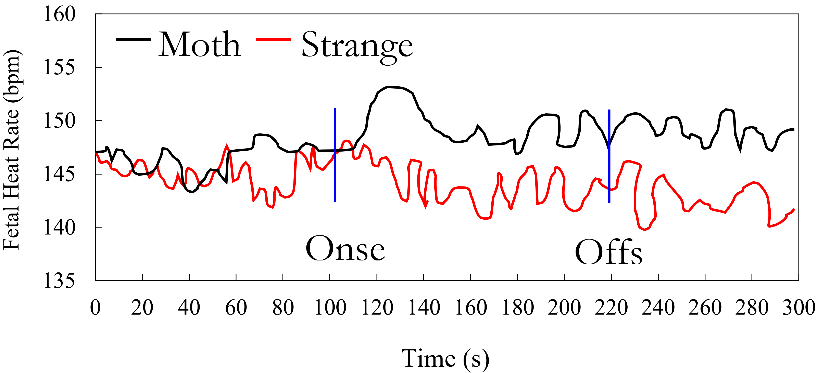Investigating the Influence of Familiarity in a Three-Dimensional Soundscape of Multisensory Factors Shaping Fetal Perception
Keywords:
Spatial Influences, Fetal familiarity, Voice recognition, Sound stimulation, Stranger's voice.Abstract
The ability of human fetuses to recognize their mother's voice was studied in this research. Sixty full-term fetuses were randomly divided into two groups: those who were read a taped recording by their mothers or those who were read the same recording by a female stranger. Unfortunately, our in-depth acoustic research showed no discernible difference beyond a fleeting shadow in the here and now. To explore the duration spent moving across all intervals, the frequency of movements in each temporal realm, and the epoch at which the very first movement occurred, we employed the powerful tool of repeated measures analysis of variance (ANOVA) in the name of scientific research. A peaceful calm pervaded the delicate balance of information, creating an air of mystery. Experience has shown to influence fetal sound processing since different behaviors have been discovered in reaction to familiar and unfamiliar sounds. It lends credence to the idea that there is some interplay between the genetic expression of brain development and the experience of a given species, which is central to the epigenetic model of speech perception. The speaker is roughly 10 centimeters above the mother's belly, and the average sound pressure level (SPL) is 95 dB. No stimulation, no sound (from mother or stranger), and no stimulation lasts two minutes. The fetal heart rate increases for 4 minutes when the mother's voice is present, while the fetal heart rate lowers for 4 minutes when an unfamiliar voice is present. Our investigations, however, went far beyond the domain of pulsations and reverberations. We looked at the period beginning five seconds before the onset of sound and continuing for another five seconds to reevaluate the complex dance of fetal movement.
References
A. Taghipour, A. Gisladottir, F. Aletta, M. Bürgin, M. Rezaei, and U. Sturm, “Improved acoustics for semi-enclosed spaces in the proximity of residential buildings,” Internoise 2022 - 51st Int. Congr. Expo. Noise Control Eng., 2022, doi: 10.3397/IN_2022_0158.
K. K. Ubrangala, “Short-term impact of anthropogenic environment on neuroplasticity: A study among humans and animals,” 2023, doi: 10.26481/DIS.20230705KK.
D. Johnston, H. Egermann, and G. Kearney, “The Use of Binaural Based Spatial Audio in the Reduction of Auditory Hypersensitivity in Autistic Young People,” Int. J. Environ. Res. Public Heal. 2022, Vol. 19, Page 12474, vol. 19, no. 19, p. 12474, Sep. 2022, doi: 10.3390/IJERPH191912474.
M. A. Lehloenya, “FOURTH SPACE: Sonic &/aural dimensions of Cape Town’s historic urban landscape,” MS thesis. Fac. Eng. Built Environ., 2022.
M. White, N. Langenheim, T. Yang, and J. Paay, “Informing Streetscape Design with Citizen Perceptions of Safety and Place: An Immersive Virtual Environment E-Participation Method,” Int. J. Environ. Res. Public Heal. 2023, Vol. 20, Page 1341, vol. 20, no. 2, p. 1341, Jan. 2023, doi: 10.3390/IJERPH20021341.
C. Velasco et al., “Perspectives on Multisensory Human-Food Interaction,” Front. Comput. Sci., vol. 3, Dec. 2021, doi: 10.3389/FCOMP.2021.811311.
and E. R. Miller, Chase, “Translating Emotions from Sight to Sound,” 2023.
J. P. M. A. de S. Cardielos, “Sound Designing Brands and Establishing Sonic Identities: the Sons Em Trânsito Music Agency,” Oct. 2023, Accessed: Dec. 25, 2023. [Online]. Available: https://repositorio-aberto.up.pt/handle/10216/153884
“Building Sensory Sound Worlds at the Intersection of Music and Architecture - ProQuest.” Accessed: Dec. 25, 2023. [Online]. Available: https://www.proquest.com/openview/933f632eec3205f6de2d597b232dd137/1?pq-origsite=gscholar&cbl=18750&diss=y
F. J. Seubert, “Music Theatre without Voice Facilitating and directing diverse participation for opera, musical, and pantomime”.
B. Fritzsch, K. L. Elliott, and E. N. Yamoah, “Neurosensory development of the four brainstem-projecting sensory systems and their integration in the telencephalon,” Front. Neural Circuits, vol. 16, p. 913480, Sep. 2022, doi: 10.3389/FNCIR.2022.913480/BIBTEX.
V. Rosi, “The Metaphors of Sound: from Semantics to Acoustics - A Study of Brightness, Warmth, Roundness, and Roughness,” HAL Thesis, 2022, [Online]. Available: https://theses.hal.science/tel-03994903v1
J. O’Hagan, “Dynamic awareness techniques for VR user interactions with bystanders,” Diss. Univ. Glas., 2023.
“Mad auralities : sound and sense in contemporary performance - UBC Library Open Collections.” Accessed: Dec. 25, 2023. [Online]. Available: https://open.library.ubc.ca/soa/cIRcle/collections/ubctheses/24/items/1.0417588
K. E. Primeau, “A GIS Approach to Landscape Scale Archaeoacoustics,” Peoquest, [Online]. Available: https://www.proquest.com/openview/1a935d9ea5e463d4be15d55303103b17/1?pq-origsite=gscholar&cbl=18750&diss=y
T. Porcello and J. Patch, “Re-making sound : an experiential approach to sound studies”.
J. Popham, “Sonorous Movement: Cellistic Corporealities in Works by Helmut Lachenmann, Simon Steen-Andersen, and Johan Svensson,” Diss. Theses, Capstone Proj., Sep. 2023, Accessed: Dec. 25, 2023. [Online]. Available: https://academicworks.cuny.edu/gc_etds/5425
N. Bax, “Concrete, Space and Time: Mixed Reality and Nonlinear Narratives,” 2022.
C. Tornatzky and B. Kelley, “An Artistic Approach to Virtual Reality,” An Artist. Approach to Virtual Real., pp. 1–208, Jan. 2023, doi: 10.1201/9781003363729/ARTISTIC-APPROACH-VIRTUAL-REALITY-CYANE-TORNATZKY-BRENDAN-KELLEY.
J. P. Monger, “Attuning to Multimodal Literacies in Teacher Education: A Case Study Analysis of Preservice Teachers’ Aesthetic Reader Responses to a Wordless Picture Book,” Diss. Indiana Univ., 2023.
P. Rodgers, Design for people living with dementia. Accessed: Dec. 25, 2023. [Online]. Available: https://www.routledge.com/Design-for-People-Living-with-Dementia/A-Rodgers/p/book/9780367554750
“Interactive Museum Tours: A Guide to In-Person and Virtual Experiences - 9781538167403.” Accessed: Dec. 25, 2023. [Online]. Available: https://rowman.com/ISBN/9781538167403/Interactive-Museum-Tours-A-Guide-to-In-Person-and-Virtual-Experiences
“ Lakewood Megachurch: Bodily Dis/Orientations in a Climate of Belief | Kate Pickering - Academia.edu.” Accessed: Dec. 25, 2023. [Online]. Available: https://www.academia.edu/106603353/Lakewood_Megachurch_Bodily_Dis_Orientations_in_a_Climate_of_Belief
N. Mirzoeff, “White Sight: Visual Politics and Practices of Whiteness,” White Sight, Feb. 2023, doi: 10.7551/MITPRESS/14620.001.0001.

Published
How to Cite
Issue
Section
License
Copyright (c) 2023 50SEA

This work is licensed under a Creative Commons Attribution 4.0 International License.




















